Financial System and Auditing Report: Minty Cola Case Study Analysis
VerifiedAdded on 2020/06/04
|21
|5476
|123
Report
AI Summary
This report provides a comprehensive analysis of the financial system and auditing practices within the context of Minty Cola, a company engaged in the manufacturing of fizzy and soft drinks. The report begins by explaining the purpose and use of various accounting records, including journals, ledgers, and final accounts, emphasizing their importance in financial decision-making and compliance with standards like IFRS and IASB. It assesses the significance of fundamental accounting concepts such as accruals, economic entity, going concern, matching, and materiality. The report then identifies and analyzes the components of business risk, including cash flow management, poor cash collection, execution, and product/market risks. It further examines the control systems in place, focusing on preventative and detective controls, segregation of duties, authorization, and documentation. The report culminates in an audit plan, outlining the scope, materiality, and risk assessment, along with appropriate audit test procedures and the preparation of a draft audit report and a management letter. The analysis covers various aspects of the company's financial system and auditing practices.
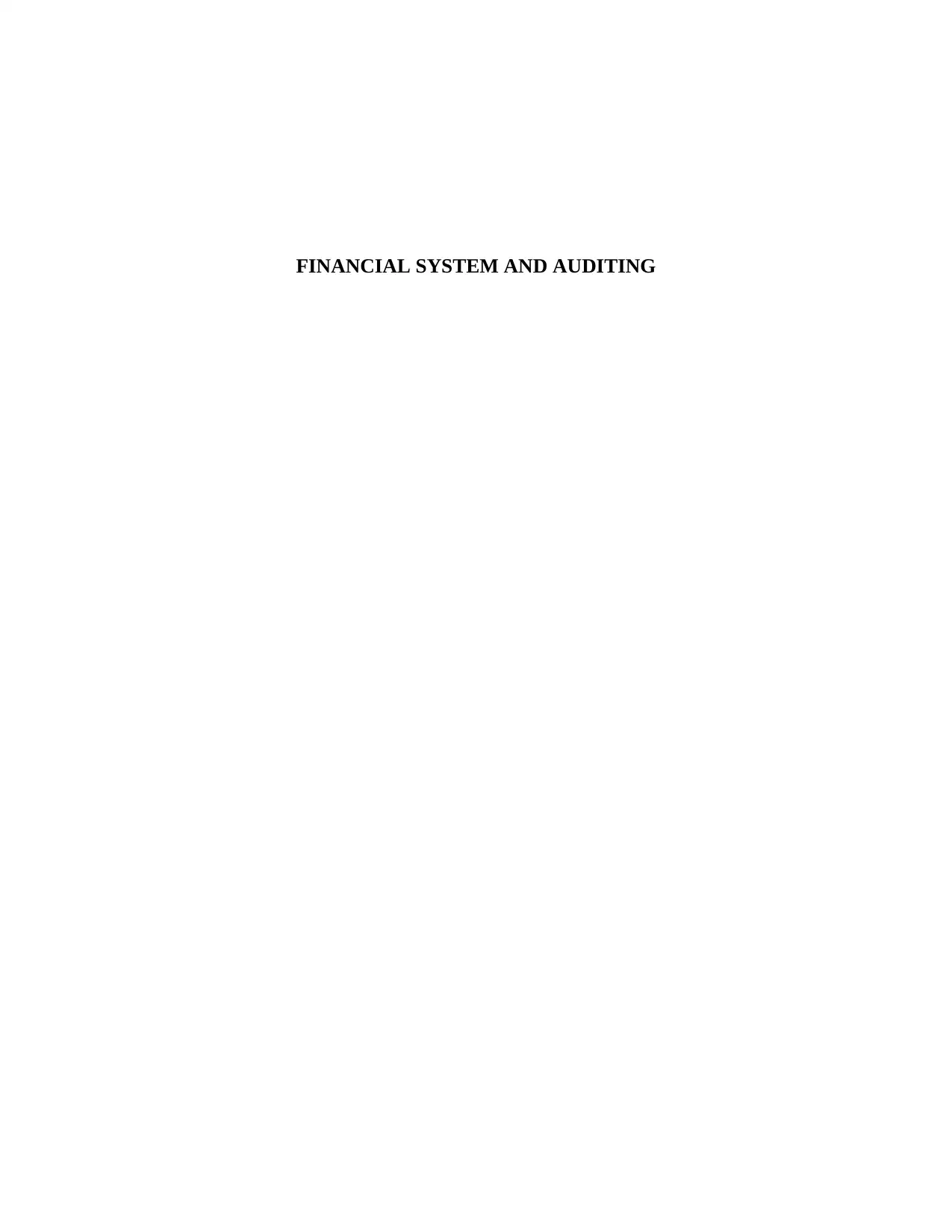
FINANCIAL SYSTEM AND AUDITING
Paraphrase This Document
Need a fresh take? Get an instant paraphrase of this document with our AI Paraphraser
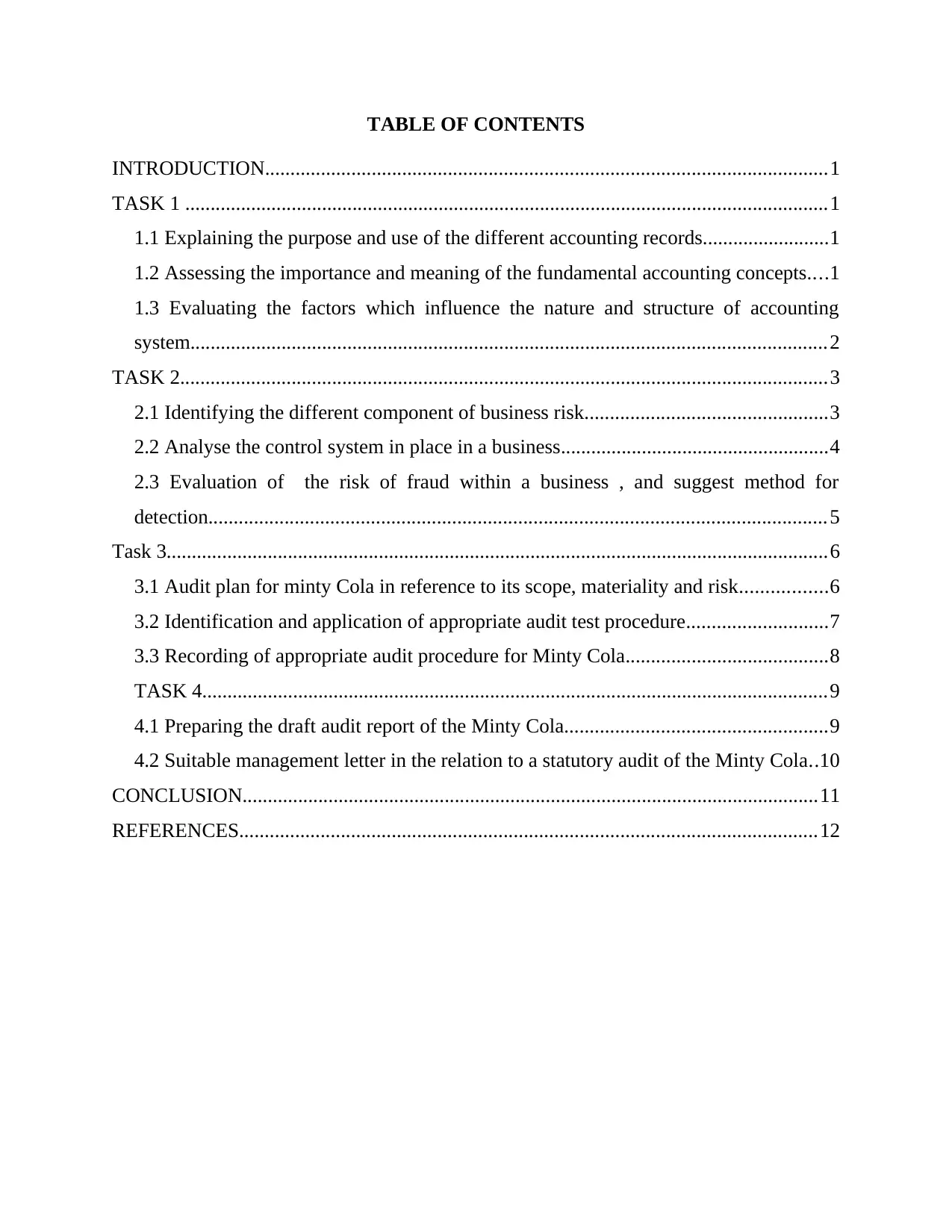
TABLE OF CONTENTS
INTRODUCTION...............................................................................................................1
TASK 1 ...............................................................................................................................1
1.1 Explaining the purpose and use of the different accounting records.........................1
1.2 Assessing the importance and meaning of the fundamental accounting concepts....1
1.3 Evaluating the factors which influence the nature and structure of accounting
system..............................................................................................................................2
TASK 2................................................................................................................................3
2.1 Identifying the different component of business risk................................................3
2.2 Analyse the control system in place in a business.....................................................4
2.3 Evaluation of the risk of fraud within a business , and suggest method for
detection..........................................................................................................................5
Task 3...................................................................................................................................6
3.1 Audit plan for minty Cola in reference to its scope, materiality and risk.................6
3.2 Identification and application of appropriate audit test procedure............................7
3.3 Recording of appropriate audit procedure for Minty Cola........................................8
TASK 4............................................................................................................................9
4.1 Preparing the draft audit report of the Minty Cola....................................................9
4.2 Suitable management letter in the relation to a statutory audit of the Minty Cola..10
CONCLUSION..................................................................................................................11
REFERENCES..................................................................................................................12
INTRODUCTION...............................................................................................................1
TASK 1 ...............................................................................................................................1
1.1 Explaining the purpose and use of the different accounting records.........................1
1.2 Assessing the importance and meaning of the fundamental accounting concepts....1
1.3 Evaluating the factors which influence the nature and structure of accounting
system..............................................................................................................................2
TASK 2................................................................................................................................3
2.1 Identifying the different component of business risk................................................3
2.2 Analyse the control system in place in a business.....................................................4
2.3 Evaluation of the risk of fraud within a business , and suggest method for
detection..........................................................................................................................5
Task 3...................................................................................................................................6
3.1 Audit plan for minty Cola in reference to its scope, materiality and risk.................6
3.2 Identification and application of appropriate audit test procedure............................7
3.3 Recording of appropriate audit procedure for Minty Cola........................................8
TASK 4............................................................................................................................9
4.1 Preparing the draft audit report of the Minty Cola....................................................9
4.2 Suitable management letter in the relation to a statutory audit of the Minty Cola..10
CONCLUSION..................................................................................................................11
REFERENCES..................................................................................................................12

INTRODUCTION
Financial system and auditing of financial system is essential for any company in
order to form a successive management. Accounting helps in measuring the success by
measuring the outcomes of the business and in alignment to the goals and objectives of
the organisation. Every business entity is required to maintain its accounting records on
the basis of accounting policies and theories. Various standards like IFRS and IASB are
their that helps the company in maintaining and reporting their financial reports.
Financial system involves the need of auditing to the company. Auditing can be internal
as well as external that helps in determining business risks and control system and also
includes audit planning and preparation of audit report. The present report is based on the
audit planning and reporting of Minty Cola Company that is indulged in the
manufacturing of fizzy drinks and soft drinks. The report explains the purpose of using
accounting records and different accounting concepts along with identifying different
components of business risk present in the given scenario.
TASK 1
1.1 Explaining the purpose and use of the different accounting records for Minty Cola
Co.
Accounting records are all those kinds of documentation and source of information
that are used to prepare and verify and then to do the audit of all those. These all are the
financial statements and the prove for the ownership of liabilities and proof of monetary
and non monetary transactions (Richard, 2017). The main purpose or aim of accounting
records is to accumulate and then report on financial information about the performance
in all terms of business. Al these informations collected are then used to make the right
decision about where and how to invest the profits and how to set off the losses of the
business organization. All the documents which are included in accounting record are
income statements, Balance sheet, Statements of cash flows, Statements of retained
earnings and disclosures that would accompany the financial statements.
Financial system and auditing of financial system is essential for any company in
order to form a successive management. Accounting helps in measuring the success by
measuring the outcomes of the business and in alignment to the goals and objectives of
the organisation. Every business entity is required to maintain its accounting records on
the basis of accounting policies and theories. Various standards like IFRS and IASB are
their that helps the company in maintaining and reporting their financial reports.
Financial system involves the need of auditing to the company. Auditing can be internal
as well as external that helps in determining business risks and control system and also
includes audit planning and preparation of audit report. The present report is based on the
audit planning and reporting of Minty Cola Company that is indulged in the
manufacturing of fizzy drinks and soft drinks. The report explains the purpose of using
accounting records and different accounting concepts along with identifying different
components of business risk present in the given scenario.
TASK 1
1.1 Explaining the purpose and use of the different accounting records for Minty Cola
Co.
Accounting records are all those kinds of documentation and source of information
that are used to prepare and verify and then to do the audit of all those. These all are the
financial statements and the prove for the ownership of liabilities and proof of monetary
and non monetary transactions (Richard, 2017). The main purpose or aim of accounting
records is to accumulate and then report on financial information about the performance
in all terms of business. Al these informations collected are then used to make the right
decision about where and how to invest the profits and how to set off the losses of the
business organization. All the documents which are included in accounting record are
income statements, Balance sheet, Statements of cash flows, Statements of retained
earnings and disclosures that would accompany the financial statements.
⊘ This is a preview!⊘
Do you want full access?
Subscribe today to unlock all pages.

Trusted by 1+ million students worldwide
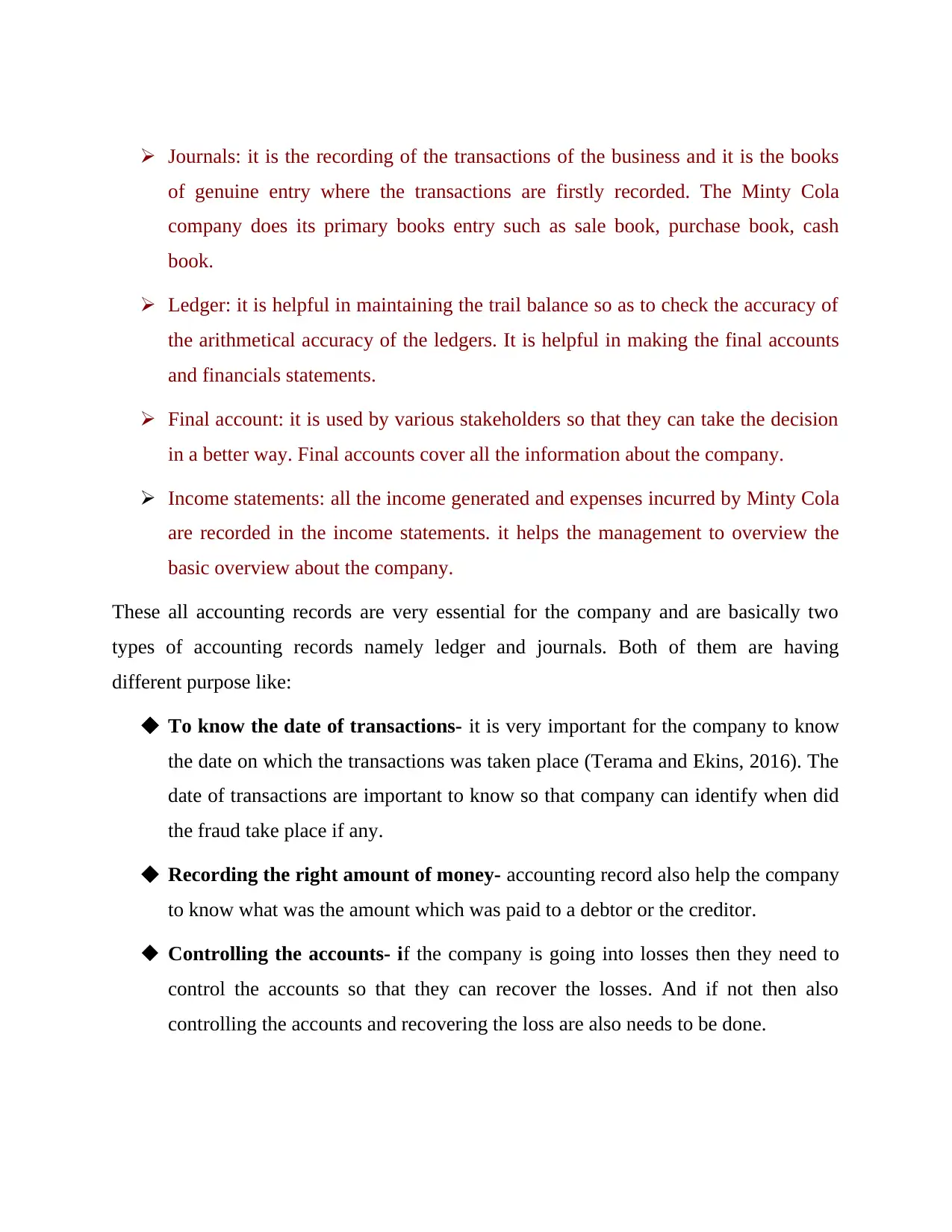
Journals: it is the recording of the transactions of the business and it is the books
of genuine entry where the transactions are firstly recorded. The Minty Cola
company does its primary books entry such as sale book, purchase book, cash
book.
Ledger: it is helpful in maintaining the trail balance so as to check the accuracy of
the arithmetical accuracy of the ledgers. It is helpful in making the final accounts
and financials statements.
Final account: it is used by various stakeholders so that they can take the decision
in a better way. Final accounts cover all the information about the company.
Income statements: all the income generated and expenses incurred by Minty Cola
are recorded in the income statements. it helps the management to overview the
basic overview about the company.
These all accounting records are very essential for the company and are basically two
types of accounting records namely ledger and journals. Both of them are having
different purpose like:
To know the date of transactions- it is very important for the company to know
the date on which the transactions was taken place (Terama and Ekins, 2016). The
date of transactions are important to know so that company can identify when did
the fraud take place if any.
Recording the right amount of money- accounting record also help the company
to know what was the amount which was paid to a debtor or the creditor.
Controlling the accounts- if the company is going into losses then they need to
control the accounts so that they can recover the losses. And if not then also
controlling the accounts and recovering the loss are also needs to be done.
of genuine entry where the transactions are firstly recorded. The Minty Cola
company does its primary books entry such as sale book, purchase book, cash
book.
Ledger: it is helpful in maintaining the trail balance so as to check the accuracy of
the arithmetical accuracy of the ledgers. It is helpful in making the final accounts
and financials statements.
Final account: it is used by various stakeholders so that they can take the decision
in a better way. Final accounts cover all the information about the company.
Income statements: all the income generated and expenses incurred by Minty Cola
are recorded in the income statements. it helps the management to overview the
basic overview about the company.
These all accounting records are very essential for the company and are basically two
types of accounting records namely ledger and journals. Both of them are having
different purpose like:
To know the date of transactions- it is very important for the company to know
the date on which the transactions was taken place (Terama and Ekins, 2016). The
date of transactions are important to know so that company can identify when did
the fraud take place if any.
Recording the right amount of money- accounting record also help the company
to know what was the amount which was paid to a debtor or the creditor.
Controlling the accounts- if the company is going into losses then they need to
control the accounts so that they can recover the losses. And if not then also
controlling the accounts and recovering the loss are also needs to be done.
Paraphrase This Document
Need a fresh take? Get an instant paraphrase of this document with our AI Paraphraser
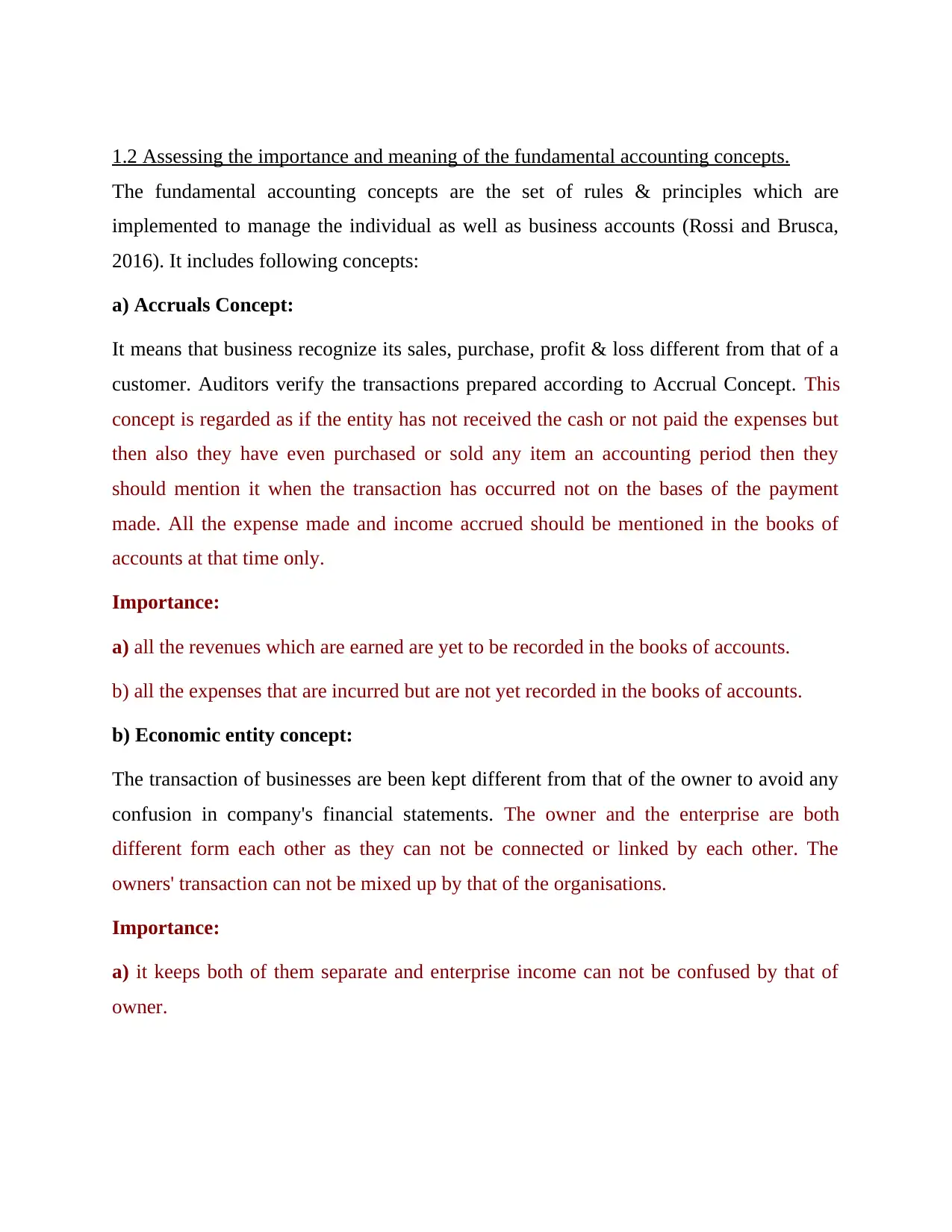
1.2 Assessing the importance and meaning of the fundamental accounting concepts.
The fundamental accounting concepts are the set of rules & principles which are
implemented to manage the individual as well as business accounts (Rossi and Brusca,
2016). It includes following concepts:
a) Accruals Concept:
It means that business recognize its sales, purchase, profit & loss different from that of a
customer. Auditors verify the transactions prepared according to Accrual Concept. This
concept is regarded as if the entity has not received the cash or not paid the expenses but
then also they have even purchased or sold any item an accounting period then they
should mention it when the transaction has occurred not on the bases of the payment
made. All the expense made and income accrued should be mentioned in the books of
accounts at that time only.
Importance:
a) all the revenues which are earned are yet to be recorded in the books of accounts.
b) all the expenses that are incurred but are not yet recorded in the books of accounts.
b) Economic entity concept:
The transaction of businesses are been kept different from that of the owner to avoid any
confusion in company's financial statements. The owner and the enterprise are both
different form each other as they can not be connected or linked by each other. The
owners' transaction can not be mixed up by that of the organisations.
Importance:
a) it keeps both of them separate and enterprise income can not be confused by that of
owner.
The fundamental accounting concepts are the set of rules & principles which are
implemented to manage the individual as well as business accounts (Rossi and Brusca,
2016). It includes following concepts:
a) Accruals Concept:
It means that business recognize its sales, purchase, profit & loss different from that of a
customer. Auditors verify the transactions prepared according to Accrual Concept. This
concept is regarded as if the entity has not received the cash or not paid the expenses but
then also they have even purchased or sold any item an accounting period then they
should mention it when the transaction has occurred not on the bases of the payment
made. All the expense made and income accrued should be mentioned in the books of
accounts at that time only.
Importance:
a) all the revenues which are earned are yet to be recorded in the books of accounts.
b) all the expenses that are incurred but are not yet recorded in the books of accounts.
b) Economic entity concept:
The transaction of businesses are been kept different from that of the owner to avoid any
confusion in company's financial statements. The owner and the enterprise are both
different form each other as they can not be connected or linked by each other. The
owners' transaction can not be mixed up by that of the organisations.
Importance:
a) it keeps both of them separate and enterprise income can not be confused by that of
owner.
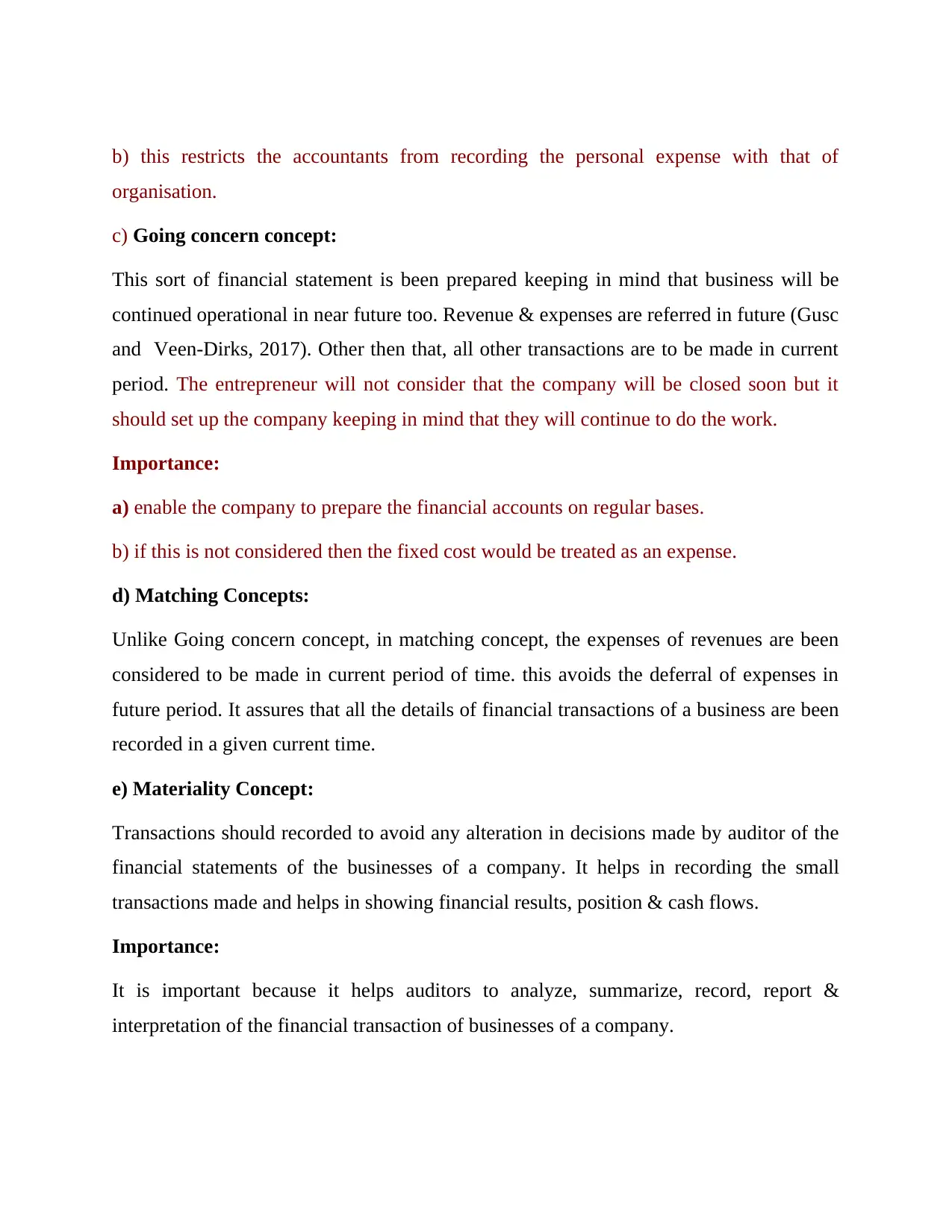
b) this restricts the accountants from recording the personal expense with that of
organisation.
c) Going concern concept:
This sort of financial statement is been prepared keeping in mind that business will be
continued operational in near future too. Revenue & expenses are referred in future (Gusc
and Veen-Dirks, 2017). Other then that, all other transactions are to be made in current
period. The entrepreneur will not consider that the company will be closed soon but it
should set up the company keeping in mind that they will continue to do the work.
Importance:
a) enable the company to prepare the financial accounts on regular bases.
b) if this is not considered then the fixed cost would be treated as an expense.
d) Matching Concepts:
Unlike Going concern concept, in matching concept, the expenses of revenues are been
considered to be made in current period of time. this avoids the deferral of expenses in
future period. It assures that all the details of financial transactions of a business are been
recorded in a given current time.
e) Materiality Concept:
Transactions should recorded to avoid any alteration in decisions made by auditor of the
financial statements of the businesses of a company. It helps in recording the small
transactions made and helps in showing financial results, position & cash flows.
Importance:
It is important because it helps auditors to analyze, summarize, record, report &
interpretation of the financial transaction of businesses of a company.
organisation.
c) Going concern concept:
This sort of financial statement is been prepared keeping in mind that business will be
continued operational in near future too. Revenue & expenses are referred in future (Gusc
and Veen-Dirks, 2017). Other then that, all other transactions are to be made in current
period. The entrepreneur will not consider that the company will be closed soon but it
should set up the company keeping in mind that they will continue to do the work.
Importance:
a) enable the company to prepare the financial accounts on regular bases.
b) if this is not considered then the fixed cost would be treated as an expense.
d) Matching Concepts:
Unlike Going concern concept, in matching concept, the expenses of revenues are been
considered to be made in current period of time. this avoids the deferral of expenses in
future period. It assures that all the details of financial transactions of a business are been
recorded in a given current time.
e) Materiality Concept:
Transactions should recorded to avoid any alteration in decisions made by auditor of the
financial statements of the businesses of a company. It helps in recording the small
transactions made and helps in showing financial results, position & cash flows.
Importance:
It is important because it helps auditors to analyze, summarize, record, report &
interpretation of the financial transaction of businesses of a company.
⊘ This is a preview!⊘
Do you want full access?
Subscribe today to unlock all pages.

Trusted by 1+ million students worldwide
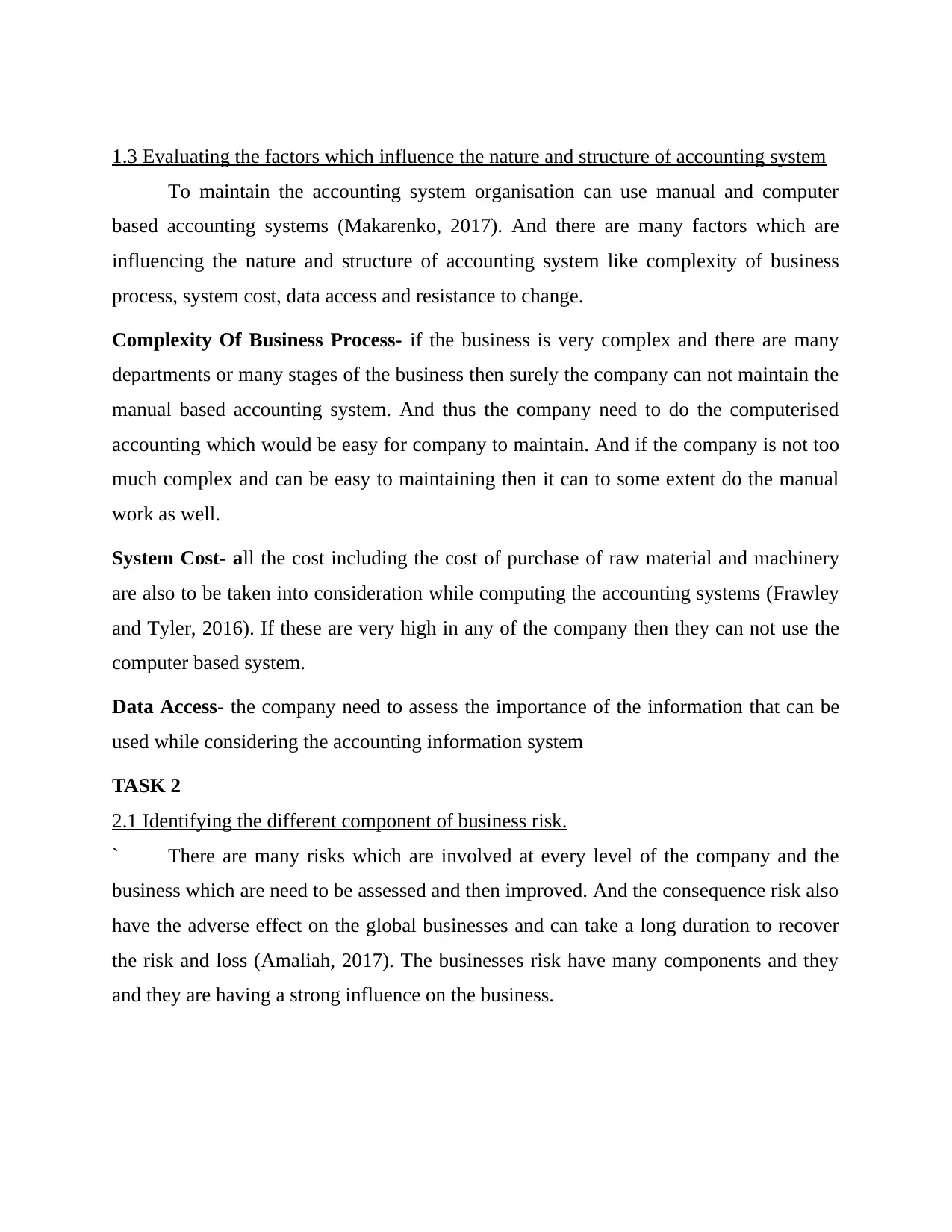
1.3 Evaluating the factors which influence the nature and structure of accounting system
To maintain the accounting system organisation can use manual and computer
based accounting systems (Makarenko, 2017). And there are many factors which are
influencing the nature and structure of accounting system like complexity of business
process, system cost, data access and resistance to change.
Complexity Of Business Process- if the business is very complex and there are many
departments or many stages of the business then surely the company can not maintain the
manual based accounting system. And thus the company need to do the computerised
accounting which would be easy for company to maintain. And if the company is not too
much complex and can be easy to maintaining then it can to some extent do the manual
work as well.
System Cost- all the cost including the cost of purchase of raw material and machinery
are also to be taken into consideration while computing the accounting systems (Frawley
and Tyler, 2016). If these are very high in any of the company then they can not use the
computer based system.
Data Access- the company need to assess the importance of the information that can be
used while considering the accounting information system
TASK 2
2.1 Identifying the different component of business risk.
` There are many risks which are involved at every level of the company and the
business which are need to be assessed and then improved. And the consequence risk also
have the adverse effect on the global businesses and can take a long duration to recover
the risk and loss (Amaliah, 2017). The businesses risk have many components and they
and they are having a strong influence on the business.
To maintain the accounting system organisation can use manual and computer
based accounting systems (Makarenko, 2017). And there are many factors which are
influencing the nature and structure of accounting system like complexity of business
process, system cost, data access and resistance to change.
Complexity Of Business Process- if the business is very complex and there are many
departments or many stages of the business then surely the company can not maintain the
manual based accounting system. And thus the company need to do the computerised
accounting which would be easy for company to maintain. And if the company is not too
much complex and can be easy to maintaining then it can to some extent do the manual
work as well.
System Cost- all the cost including the cost of purchase of raw material and machinery
are also to be taken into consideration while computing the accounting systems (Frawley
and Tyler, 2016). If these are very high in any of the company then they can not use the
computer based system.
Data Access- the company need to assess the importance of the information that can be
used while considering the accounting information system
TASK 2
2.1 Identifying the different component of business risk.
` There are many risks which are involved at every level of the company and the
business which are need to be assessed and then improved. And the consequence risk also
have the adverse effect on the global businesses and can take a long duration to recover
the risk and loss (Amaliah, 2017). The businesses risk have many components and they
and they are having a strong influence on the business.
Paraphrase This Document
Need a fresh take? Get an instant paraphrase of this document with our AI Paraphraser
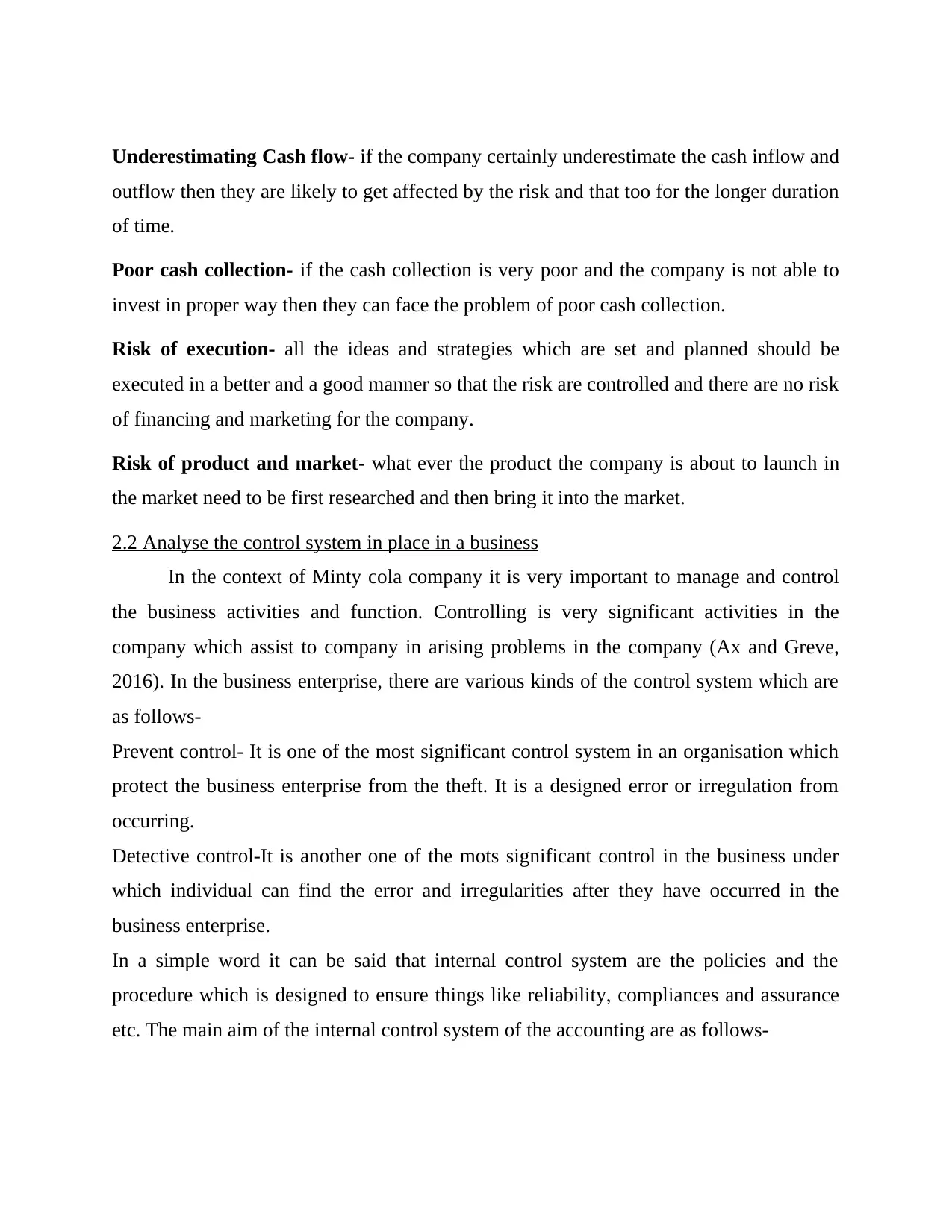
Underestimating Cash flow- if the company certainly underestimate the cash inflow and
outflow then they are likely to get affected by the risk and that too for the longer duration
of time.
Poor cash collection- if the cash collection is very poor and the company is not able to
invest in proper way then they can face the problem of poor cash collection.
Risk of execution- all the ideas and strategies which are set and planned should be
executed in a better and a good manner so that the risk are controlled and there are no risk
of financing and marketing for the company.
Risk of product and market- what ever the product the company is about to launch in
the market need to be first researched and then bring it into the market.
2.2 Analyse the control system in place in a business
In the context of Minty cola company it is very important to manage and control
the business activities and function. Controlling is very significant activities in the
company which assist to company in arising problems in the company (Ax and Greve,
2016). In the business enterprise, there are various kinds of the control system which are
as follows-
Prevent control- It is one of the most significant control system in an organisation which
protect the business enterprise from the theft. It is a designed error or irregulation from
occurring.
Detective control-It is another one of the mots significant control in the business under
which individual can find the error and irregularities after they have occurred in the
business enterprise.
In a simple word it can be said that internal control system are the policies and the
procedure which is designed to ensure things like reliability, compliances and assurance
etc. The main aim of the internal control system of the accounting are as follows-
outflow then they are likely to get affected by the risk and that too for the longer duration
of time.
Poor cash collection- if the cash collection is very poor and the company is not able to
invest in proper way then they can face the problem of poor cash collection.
Risk of execution- all the ideas and strategies which are set and planned should be
executed in a better and a good manner so that the risk are controlled and there are no risk
of financing and marketing for the company.
Risk of product and market- what ever the product the company is about to launch in
the market need to be first researched and then bring it into the market.
2.2 Analyse the control system in place in a business
In the context of Minty cola company it is very important to manage and control
the business activities and function. Controlling is very significant activities in the
company which assist to company in arising problems in the company (Ax and Greve,
2016). In the business enterprise, there are various kinds of the control system which are
as follows-
Prevent control- It is one of the most significant control system in an organisation which
protect the business enterprise from the theft. It is a designed error or irregulation from
occurring.
Detective control-It is another one of the mots significant control in the business under
which individual can find the error and irregularities after they have occurred in the
business enterprise.
In a simple word it can be said that internal control system are the policies and the
procedure which is designed to ensure things like reliability, compliances and assurance
etc. The main aim of the internal control system of the accounting are as follows-

Segregation of the responsibility and duties- The major benefit of the control
system is to proper segregation of the duties and responsibility of each member
who are working in the Minty cola company (Brown and et.al., 2016).
Proper authorization of management-It is another major benefit of the control
system which assist in proper authorization of management within the company.
In the Minty cola company with help of several tools and techniques of control
system company can effectively manage the business activities and functions
(Daskalakis, Devanur and Weinberg, 2015).
Proper documentation of the accounting- It is another significant benefit of control
system under which company can easily prepare the documentation of the
accounting.
There are various key factors of the internal control for the purchase which are as
follows-
Proper management of the cash management on the monthly basis
Documentation of the all transactions
In the context of business, there are various kinds of the strategies which assist in
overcome the fraud identification in the Minty cola company which are as follows-
Implement control system- This is another one of the most significant
strategy to overcome the fraud and thefts from the business enterprise.
Internal control are plan and program which is implemented to the
safeguard the company assets. Segregation of the responsibility is
significant element of internal control that assist in integrity of its
accounting record and detect the thefts and fraud (Giri and Sharma, 2014).
Making employees awareness-This is one of the most significant strategy
by which company can protect its business from the fraud and theft. In
order to protect its business and survive its operation in effective manner, it
is very important for the management to provide effective education,
system is to proper segregation of the duties and responsibility of each member
who are working in the Minty cola company (Brown and et.al., 2016).
Proper authorization of management-It is another major benefit of the control
system which assist in proper authorization of management within the company.
In the Minty cola company with help of several tools and techniques of control
system company can effectively manage the business activities and functions
(Daskalakis, Devanur and Weinberg, 2015).
Proper documentation of the accounting- It is another significant benefit of control
system under which company can easily prepare the documentation of the
accounting.
There are various key factors of the internal control for the purchase which are as
follows-
Proper management of the cash management on the monthly basis
Documentation of the all transactions
In the context of business, there are various kinds of the strategies which assist in
overcome the fraud identification in the Minty cola company which are as follows-
Implement control system- This is another one of the most significant
strategy to overcome the fraud and thefts from the business enterprise.
Internal control are plan and program which is implemented to the
safeguard the company assets. Segregation of the responsibility is
significant element of internal control that assist in integrity of its
accounting record and detect the thefts and fraud (Giri and Sharma, 2014).
Making employees awareness-This is one of the most significant strategy
by which company can protect its business from the fraud and theft. In
order to protect its business and survive its operation in effective manner, it
is very important for the management to provide effective education,
⊘ This is a preview!⊘
Do you want full access?
Subscribe today to unlock all pages.

Trusted by 1+ million students worldwide

knowledge and awareness about the business protect and relevant thefts and
fraud which can occurs within the business (Guinea, 2016). With assistance
of this strategy company can keep secure its business from thefts and
frauds.
Hiring experts- This is the best strategy for the fraud identification in this
company can protect its business from fraud and theft. In this company
should hire the experts such as certified fraud examiners, certified public
accountants, CPA etc. These professionals can give the varieties of services
to the company through which it can protect its business enterprise (Taylor
and Scapens, 2016).
2.3 Evaluation of the risk of fraud within a business , and suggest method for detection
In the organisation fraud detection is the clarification of actual and potential fraud. It
applies the improvement for an appropriate method and the procedure to identify the
early warning signs of fraud. It is very important to evaluation of the risk within the
business so as company can easily protect its business activities and functions.
Fraud detection involves the interrelation of the following techniques:
Proactive( e.g. Risk assessments) and reactive(e.g. responding to reports of fraud).
Manual (e.g. spot audits) and automated (e.g. responding to report of fraud).
In an organisation it should the form part of overall anti-fraud strategy covering the
prevention , investigation, detection of fraud (Järvinen, 2016). All organisation are get
affected to fraud. According to the size and the nature of the organisation and the sector
in which it operates by the different fraud risk. The appropriate method of fraud detection
saves the money and protects organisation and their shareholders employees and their
customers. The organisational promotional detection activities can also act as a deterrent
to would -be fraudsters.
Some other advantage are:
-Classification of vulnerable employees at risk to fraud.
fraud which can occurs within the business (Guinea, 2016). With assistance
of this strategy company can keep secure its business from thefts and
frauds.
Hiring experts- This is the best strategy for the fraud identification in this
company can protect its business from fraud and theft. In this company
should hire the experts such as certified fraud examiners, certified public
accountants, CPA etc. These professionals can give the varieties of services
to the company through which it can protect its business enterprise (Taylor
and Scapens, 2016).
2.3 Evaluation of the risk of fraud within a business , and suggest method for detection
In the organisation fraud detection is the clarification of actual and potential fraud. It
applies the improvement for an appropriate method and the procedure to identify the
early warning signs of fraud. It is very important to evaluation of the risk within the
business so as company can easily protect its business activities and functions.
Fraud detection involves the interrelation of the following techniques:
Proactive( e.g. Risk assessments) and reactive(e.g. responding to reports of fraud).
Manual (e.g. spot audits) and automated (e.g. responding to report of fraud).
In an organisation it should the form part of overall anti-fraud strategy covering the
prevention , investigation, detection of fraud (Järvinen, 2016). All organisation are get
affected to fraud. According to the size and the nature of the organisation and the sector
in which it operates by the different fraud risk. The appropriate method of fraud detection
saves the money and protects organisation and their shareholders employees and their
customers. The organisational promotional detection activities can also act as a deterrent
to would -be fraudsters.
Some other advantage are:
-Classification of vulnerable employees at risk to fraud.
Paraphrase This Document
Need a fresh take? Get an instant paraphrase of this document with our AI Paraphraser
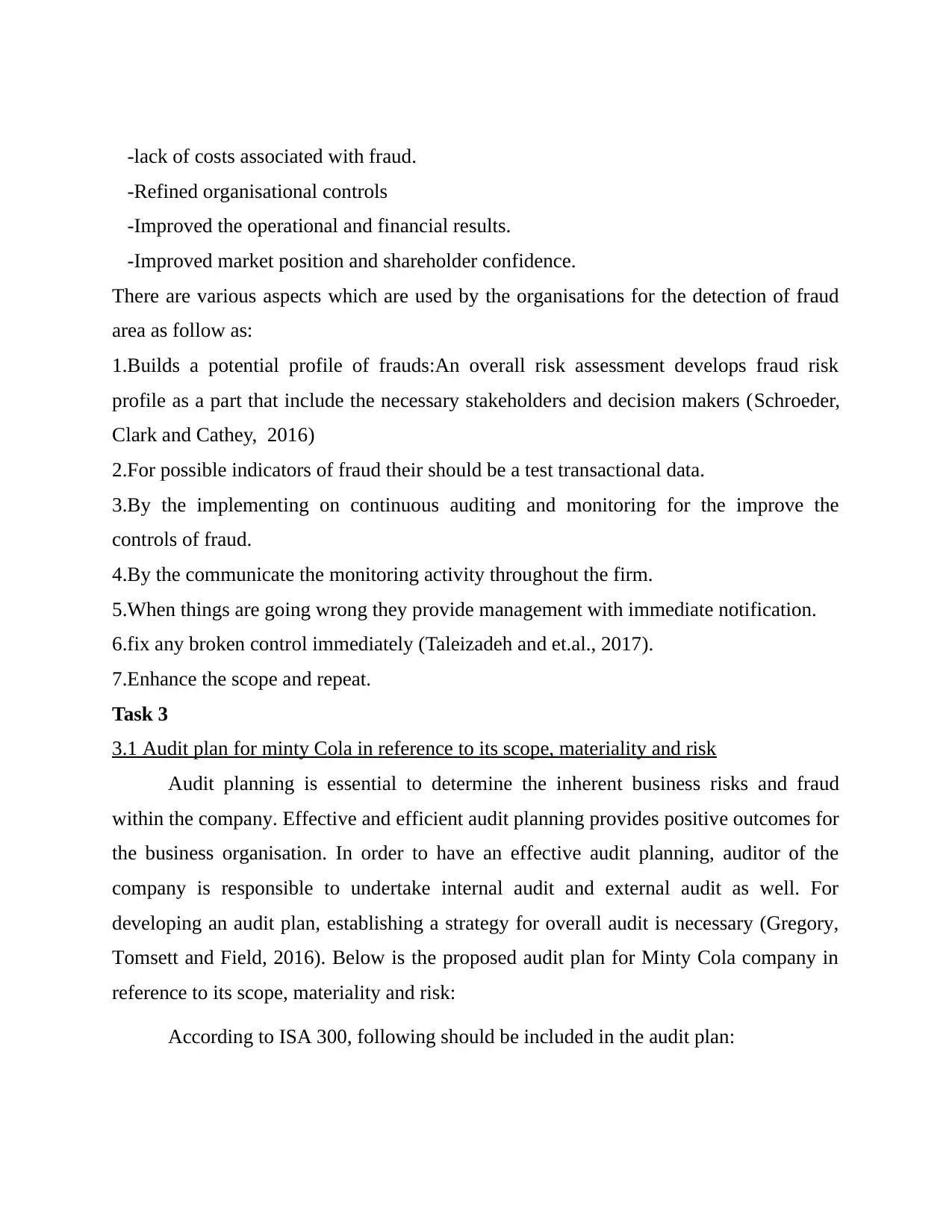
-lack of costs associated with fraud.
-Refined organisational controls
-Improved the operational and financial results.
-Improved market position and shareholder confidence.
There are various aspects which are used by the organisations for the detection of fraud
area as follow as:
1.Builds a potential profile of frauds:An overall risk assessment develops fraud risk
profile as a part that include the necessary stakeholders and decision makers (Schroeder,
Clark and Cathey, 2016)
2.For possible indicators of fraud their should be a test transactional data.
3.By the implementing on continuous auditing and monitoring for the improve the
controls of fraud.
4.By the communicate the monitoring activity throughout the firm.
5.When things are going wrong they provide management with immediate notification.
6.fix any broken control immediately (Taleizadeh and et.al., 2017).
7.Enhance the scope and repeat.
Task 3
3.1 Audit plan for minty Cola in reference to its scope, materiality and risk
Audit planning is essential to determine the inherent business risks and fraud
within the company. Effective and efficient audit planning provides positive outcomes for
the business organisation. In order to have an effective audit planning, auditor of the
company is responsible to undertake internal audit and external audit as well. For
developing an audit plan, establishing a strategy for overall audit is necessary (Gregory,
Tomsett and Field, 2016). Below is the proposed audit plan for Minty Cola company in
reference to its scope, materiality and risk:
According to ISA 300, following should be included in the audit plan:
-Refined organisational controls
-Improved the operational and financial results.
-Improved market position and shareholder confidence.
There are various aspects which are used by the organisations for the detection of fraud
area as follow as:
1.Builds a potential profile of frauds:An overall risk assessment develops fraud risk
profile as a part that include the necessary stakeholders and decision makers (Schroeder,
Clark and Cathey, 2016)
2.For possible indicators of fraud their should be a test transactional data.
3.By the implementing on continuous auditing and monitoring for the improve the
controls of fraud.
4.By the communicate the monitoring activity throughout the firm.
5.When things are going wrong they provide management with immediate notification.
6.fix any broken control immediately (Taleizadeh and et.al., 2017).
7.Enhance the scope and repeat.
Task 3
3.1 Audit plan for minty Cola in reference to its scope, materiality and risk
Audit planning is essential to determine the inherent business risks and fraud
within the company. Effective and efficient audit planning provides positive outcomes for
the business organisation. In order to have an effective audit planning, auditor of the
company is responsible to undertake internal audit and external audit as well. For
developing an audit plan, establishing a strategy for overall audit is necessary (Gregory,
Tomsett and Field, 2016). Below is the proposed audit plan for Minty Cola company in
reference to its scope, materiality and risk:
According to ISA 300, following should be included in the audit plan:
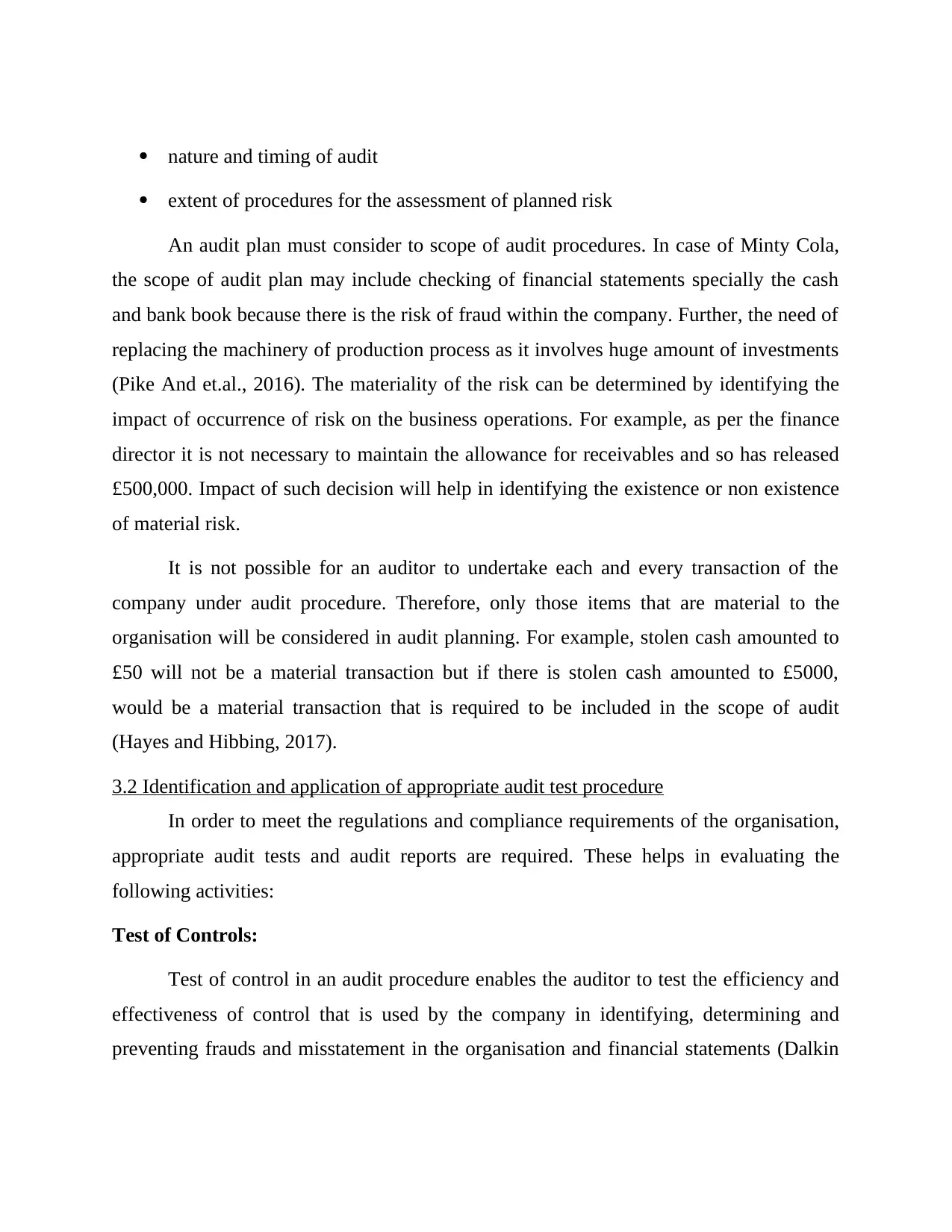
nature and timing of audit
extent of procedures for the assessment of planned risk
An audit plan must consider to scope of audit procedures. In case of Minty Cola,
the scope of audit plan may include checking of financial statements specially the cash
and bank book because there is the risk of fraud within the company. Further, the need of
replacing the machinery of production process as it involves huge amount of investments
(Pike And et.al., 2016). The materiality of the risk can be determined by identifying the
impact of occurrence of risk on the business operations. For example, as per the finance
director it is not necessary to maintain the allowance for receivables and so has released
£500,000. Impact of such decision will help in identifying the existence or non existence
of material risk.
It is not possible for an auditor to undertake each and every transaction of the
company under audit procedure. Therefore, only those items that are material to the
organisation will be considered in audit planning. For example, stolen cash amounted to
£50 will not be a material transaction but if there is stolen cash amounted to £5000,
would be a material transaction that is required to be included in the scope of audit
(Hayes and Hibbing, 2017).
3.2 Identification and application of appropriate audit test procedure
In order to meet the regulations and compliance requirements of the organisation,
appropriate audit tests and audit reports are required. These helps in evaluating the
following activities:
Test of Controls:
Test of control in an audit procedure enables the auditor to test the efficiency and
effectiveness of control that is used by the company in identifying, determining and
preventing frauds and misstatement in the organisation and financial statements (Dalkin
extent of procedures for the assessment of planned risk
An audit plan must consider to scope of audit procedures. In case of Minty Cola,
the scope of audit plan may include checking of financial statements specially the cash
and bank book because there is the risk of fraud within the company. Further, the need of
replacing the machinery of production process as it involves huge amount of investments
(Pike And et.al., 2016). The materiality of the risk can be determined by identifying the
impact of occurrence of risk on the business operations. For example, as per the finance
director it is not necessary to maintain the allowance for receivables and so has released
£500,000. Impact of such decision will help in identifying the existence or non existence
of material risk.
It is not possible for an auditor to undertake each and every transaction of the
company under audit procedure. Therefore, only those items that are material to the
organisation will be considered in audit planning. For example, stolen cash amounted to
£50 will not be a material transaction but if there is stolen cash amounted to £5000,
would be a material transaction that is required to be included in the scope of audit
(Hayes and Hibbing, 2017).
3.2 Identification and application of appropriate audit test procedure
In order to meet the regulations and compliance requirements of the organisation,
appropriate audit tests and audit reports are required. These helps in evaluating the
following activities:
Test of Controls:
Test of control in an audit procedure enables the auditor to test the efficiency and
effectiveness of control that is used by the company in identifying, determining and
preventing frauds and misstatement in the organisation and financial statements (Dalkin
⊘ This is a preview!⊘
Do you want full access?
Subscribe today to unlock all pages.

Trusted by 1+ million students worldwide
1 out of 21
Related Documents
Your All-in-One AI-Powered Toolkit for Academic Success.
+13062052269
info@desklib.com
Available 24*7 on WhatsApp / Email
![[object Object]](/_next/static/media/star-bottom.7253800d.svg)
Unlock your academic potential
Copyright © 2020–2025 A2Z Services. All Rights Reserved. Developed and managed by ZUCOL.





